
The Hepialidae are a family of insects in the lepidopteran order. Moths of this family are often referred to as swift moths or ghost moths.

Tineidae is a family of moths in the order Lepidoptera described by Pierre André Latreille in 1810. Collectively, they are known as fungus moths or tineid moths. The family contains considerably more than 3,000 species in more than 300 genera. Most of the tineid moths are small or medium-sized, with wings held roofwise over the body when at rest. They are particularly common in the Palaearctic, but many occur elsewhere, and some are found very widely as introduced species.
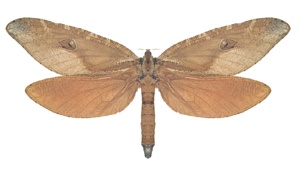
Zelotypia is a monotypic moth genus of the family Hepialidae. The only described species is Z. stacyi, the bentwing ghost moth, which is only found in Queensland and New South Wales, Australia. This is a very large species with a wingspan of up to 250 mm. The larva feeds and pupates in the trunks and branches of Eucalyptus.

The yellow-footed rock-wallaby, formerly known as the ring-tailed rock-wallaby, is a member of the macropod family.

Lampides boeticus, the pea blue, or long-tailed blue, is a small butterfly that belongs to the lycaenids or gossamer-winged family.
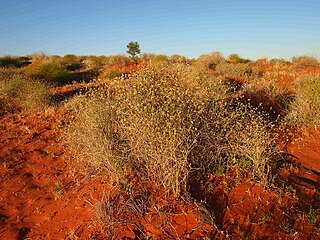
Zygochloa is a genus of desert plants in the grass family known only from Australia. The only known species is Zygochloa paradoxa, commonly known as sandhill canegrass. It occurs in extremely arid areas such as the Simpson Desert.

The Papuan sheath-tailed bat is a species of bat in the family Emballonuridae which occurs at the Cape York Peninsula and New Guinea. The poorly known species hunts in open forests for night flying insects.

Scythropia crataegella, the hawthorn moth, is a species of moth in the family Plutellidae from western Eurasia. It is usually placed in a small subfamily Scythropiinae, which is sometimes included in the Yponomeutinae of the Yponomeutidae.
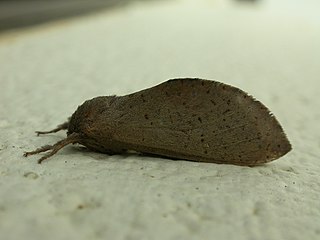
Elhamma australasiae is a moth of the family Hepialidae. It is found along the eastern seaboard of Australia.

Etiella behrii is a species of moth of the family Pyralidae, occurring sporadically but when present considered a serious pest of agricultural crops throughout parts of Australia.
Acridotarsa is a genus of moths belonging to the family Tineidae. The genus was described by Edward Meyrick in 1893.

Erechthias is a genus of the fungus moth family, Tineidae. Therein, it belongs to the subfamily Erechthiinae, of which it is the type genus. The exact circumscription of this genus is still disputed, but it may encompass more than 150 species.
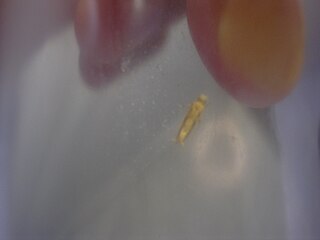
Erechthias minuscula, the erechthias clothes moth, is a moth of the family Tineidae. It was first described by Lord Walsingham in 1897. It is widespread and has been recorded from Africa, Sri Lanka, Java, Australia, the Caroline Islands, Fiji, Samoa, the Marquesas, the West Indies, Hawaii and Florida.

Erechthias simulans is a species of fungus moth. It is here considered to belong to the somewhat controversial type genus of its subfamily Erechthiinae, though even fairly recently some authors have proposed to retain other genera such as Decadarchis separate from Erechthias. Decadarchis, with E. simulans as type species, would in fact contain this moth and its closest relatives, regardless whether it is recognized as full genus or as subgenus. These relatives are generally held to be a group of mainly Polynesian species. E. simulans has also been mistaken for a species of the closely related genus Comodica; while the delimitation of this versus Erechthias/Decadarchis is not universally agreed upon, E. simulans is not included in Comodica anymore by modern authors.
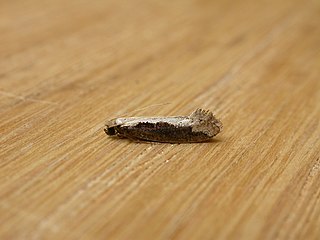
Erechthias diaphora is a moth of the family Tineidae. It is known from Australia, including New South Wales, Queensland and Victoria.

Erechthias darwini is a moth of the family Tineidae. It is endemic to St. Paul’s Rocks, a group of 15 small islets and rocks in the central equatorial Atlantic Ocean. It was first recorded by Charles Darwin.
Bidenichthys beeblebroxi is a species of common reef fish of the family Bythitidae, and one of three species in the genus Bidenichthys. The species is found in the coastal waters off North Island and northern South Island, New Zealand. It is a common, uniformly gray-brown fish, ranging from SL 6.5–9.5 centimetres long in one study, found in holes beneath rocks and boulders in kelp forest and other reef habitats from the surface down to depths of 30 metres (98 ft). The species was described by Paulin in 1995.
Dichomeris leuconotella is a moth in the family Gelechiidae. It was described by August Busck in 1904. It is found in North America, where it has been recorded from Nova Scotia to Maryland, southern Canada, Washington, Colorado, Iowa and Indiana. The habitat consists of open fields.
Tineola anaphecola is a species of fungus moth. It is native to tropical the Democratic Republic of the Congo.

Erechthias indicans is a species of moth in the family Tineidae. It was first described by Edward Meyrick in 1923. This species is endemic to New Zealand and has been observed in Wellington in January.















